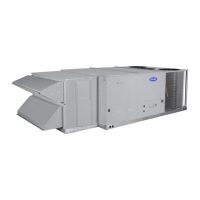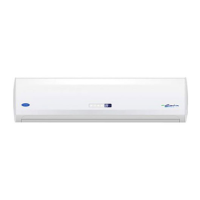
Do you have a question about the Carrier Crystal Plus 53KHFT18-708 and is the answer not in the manual?
| Cooling Capacity | 1.5 Ton |
|---|---|
| Refrigerant | R32 |
| Compressor Type | Rotary |
| Outdoor Noise Level | 52 dB |
| Star Rating | 3 Star |
| Cooling Capacity (BTU) | 18000 BTU |
| Outdoor Unit Weight | 32 kg |
| Type | Split |
| Power Supply | 230V, 50Hz |
Lists essential tools required for the installation process.
Outlines essential steps after installation, including run tests and customer guidance.
Highlights essential safety measures to be followed during installation and maintenance.
Details conditions under which the product warranty may not apply.
Provides a visual overview of indoor and outdoor unit components for different model sizes.
Explains model designations and differentiates between heat pump and cool-only configurations.
Specifies the temperature ranges for optimal cooling performance.
Specifies the temperature ranges for optimal heating performance.
Details the required voltage and frequency for the unit's power supply.
Lists the dimensions and weight specifications for the indoor air conditioner unit.
Lists the dimensions and weight specifications for the outdoor air conditioner unit.
Guides on choosing an ideal location for the indoor unit, considering clearances and airflow.
Outlines acceptable locations for outdoor unit placement and general site requirements.
Details factors to consider for optimal outdoor unit location, avoiding performance degradation.
Specifies required clearances around a single outdoor unit for proper airflow and service access.
Details required clearances for multiple outdoor units installed in series.
Lists criteria to verify for the correct placement of the indoor unit.
Lists criteria to verify for the correct placement of the outdoor unit.
Verifies proper routing and length of refrigerant piping between units.
Lists standard installation parts provided with the unit, including descriptions and quantities.
Details additional installation accessories supplied for export markets, specifically flare nuts.
Guides on preparing the indoor unit and wall for installation, including hole drilling.
Details the step-by-step process of physically mounting the indoor unit onto the wall bracket.
Illustrates the procedure for inserting batteries into the wireless remote control.
Provides instructions on operating the remote control and its optimal usage conditions.
Outlines initial preparations for the outdoor unit, including unpacking and lifting.
Details the assembly and mounting of the wall support bracket for the outdoor unit.
Provides a visual overview of the refrigerant connection process steps.
Gives detailed instructions and recommendations for connecting refrigerant piping.
Provides data on piping diameters, lengths, and vertical/horizontal distances for optimal performance.
Details how to calculate and add refrigerant for extended piping lengths and notes on over/undercharging.
Details steps for cutting, reaming, and flaring refrigerant piping lines before connections.
Provides step-by-step instructions for connecting refrigerant lines to the indoor unit.
Details the process of connecting refrigerant lines to the outdoor unit's flare valves.
Explains procedures for purging air from the system using refrigerant or a vacuum pump.
Outlines methods for checking refrigerant piping joints for leaks.
Specifies the required size and material for the indoor unit's condensate drain line.
Shows the possible locations for routing the condensate drain line from the indoor unit.
Provides instructions and cautions for correctly installing the condensate drain line to ensure proper drainage.
Covers electrical wiring between the power supply and the air conditioner's circuit breaker.
Details electrical connections between the indoor unit, outdoor unit, and the circuit breaker.
Provides essential electrical specifications, including consumption and circuit breaker ratings for different models.
Outlines preparation steps for connecting electrical cables to the outdoor unit's terminal block.
Specific wiring instructions for heat pump systems, covering outdoor and indoor units.
General guidelines for field wiring connections for cool-only and heat pump systems.
Lists checks and precautions to perform before initiating the test run.
Explains how to use the manual control button for cooling test runs in low ambient temperatures.
Details the procedure for performing a cooling test run, including measuring pressure and amps.
Details the procedure for performing a heating test run, including measuring pressure and amps.
Describes how to control the direction of air supply using the remote control and manual adjustments.
Explains the automatic vertical air direction adjustment based on operating mode.
Details how to activate and deactivate the automatic swinging of horizontal louvers for air distribution.
Verifies the proper installation and mounting of the indoor unit and its components.
Verifies the proper installation and mounting of the outdoor unit and its support.
Confirms correct refrigerant line connections, insulation, and leak testing.
Ensures the condensate drain line is correctly installed for proper water flow.
Verifies correct electrical connections, voltage, wiring, and grounding.
Checks for proper bundling of pipes/cables and sealing of wall passages.
Confirms that unit operation cycles, noise levels, and remote control functionality are satisfactory.
Ensures customer has been informed about unit operation, features, and manuals.
Explains the purpose and operation of the unit's self-diagnostic system for detecting faults.
Lists specific malfunctions for cool-only models and their corresponding LED indicator statuses.
Lists specific malfunctions for heat pump models and their corresponding LED indicator statuses.












